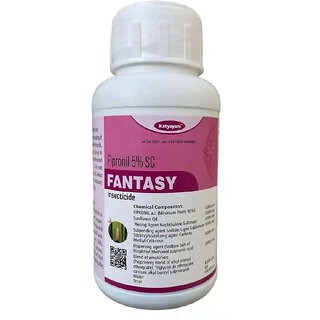
Katyayani Fipronil 5 SC Insecticide PEST CONTROL for Plants Home Garden
Quick Overview
-
TECHNICAL: FIPRONIL 5% SC (5% W/W).
Fipronil 5 SC is a phenyl pyrazole insecticide for foliar application. It has been proven to offer low dose, highly effective insect control against a broad range of economically important pests. It is also found to be effective particularly for managing thrips. Its unique mode of action allows it to control insects that have developed resistance to all other classes of insecticides.
-
MODE OF ACTION
Primarily acts as an ingestion toxicant with some complimentary contact action and acts by interfering in nerve impulse transmission. It interferes with the passage of chloride ions through the Gamma Amino Butyric Acid (GABA) regulated chloride channel, thereby disrupting CNS activity and at sufficient doses, causing insect death.
-
PLANT GROWTH ENHANCEMENT
Fipronil aids in increasing the yield of crops by controlling pests that reduce crop growth. It is observed that in the absence of injurious pests Fipronil can improve the vigor and yields of crops and therefore also the quality.
In rice, corn and sugarcane, field observations indicated the following effects:
-
More developed root system, increased numbers of tillers and more productive tillers
-
Greener plants, increase in leaf area and plant height
-
Earlier flowering and maturity of grain leading to significant increase in yields
Fipronil formulations have been designed to be compatible with a wide range of insecticides, fungicides, herbicides and liquid fertilizers. Perform a simple jar test beforehand if there is any question regarding the compatibility of these formulations with another tank mix partner.
-
CROP AND TARGET PESTS
-
Crop - Target Pest
-
Rice - Green Leaf Hopper, Gall midge Whorl Maggot, Stem Borer, Leaf Folder, Brown Plant Hopper, White Backed Plant Hopper
-
Chilli - Thrips, Aphids and Fruit Borer
-
Cabbage - Diamond-back Moth
Sugarcane Early Shoot Borer and Root Borer
-
Cotton - Aphid, Jassid, Thrips, White Fly
Boll Worms
Avoid spray during flowering when honey bee activity is maximum.
